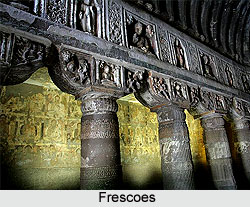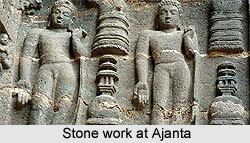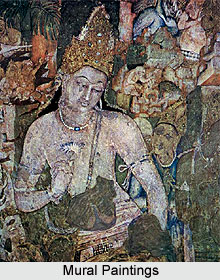Cave 1 consists of a verandah, a hall, groups of cells and a sanctuary, it is one of the finest monasteries at Ajanta, distinguished from the others by its decorated facade, the beauty of which, though somewhat marred by the collapse of the small portico originally supported on two pillars in front, lies in its richly-carved pillars and entablature.
The columns, six in number, have square bases with figures of small dwarfs at the four corners and elaborately-decorated bracket-capitals. The shafts, however, vary in shape and design. The two central ones are first octagonal, then sixteen-sided and next fluted, with bands of fine tracery of singular beauty. The central compartment of their capitals is adorned with a squat dwarf, and the projecting ends have the figures of flying couples with garlands and flowers in their hands.
Underlying the capital is a square abacus, delicately carved with makara-motifs and supported by dwarfs, below which is an amalakn-like member between two fillets. The next two pillars have above the octagon spiral flutings with belts of tracery. Their crowning members are similar to those of the central pillars, except that the central panels contain figures of Buddha in preaching attitude.
 Besides the pillars, the verandah has two pilasters carved with a half and a full lotus-medallion of a most ornate pattern. The lowest frieze of the architrave is decorated with varied motifs taken from human and animal worlds, of which elephants and buffalo-fights are rendered with consummate skill. Particularly interesting is the return of this frieze on the left side-chapel, on which are represented three out of the four Ominous Sights, viz., a sick man, an old man and a corpse, which Gautama encountered in the course of his drives through the pleasure-gardens and which were ultimately responsible for his decision of renunciation.
Besides the pillars, the verandah has two pilasters carved with a half and a full lotus-medallion of a most ornate pattern. The lowest frieze of the architrave is decorated with varied motifs taken from human and animal worlds, of which elephants and buffalo-fights are rendered with consummate skill. Particularly interesting is the return of this frieze on the left side-chapel, on which are represented three out of the four Ominous Sights, viz., a sick man, an old man and a corpse, which Gautama encountered in the course of his drives through the pleasure-gardens and which were ultimately responsible for his decision of renunciation.
The verandah has a cell at either end. Outside the verandah is a raised pillared porch at either extremity. The one on the right leads to a cell, while that on the left used to lead to two cells, one of which has perished. There was a second cell adjoining the porch on the right side.
Access to the hall is provided by three doors, the central one, flanked by a window on either side, being richly carved with bands of human and floral motifs. Next to the innermost band of floral patterns is a projecting member carved with figures in compartments. The outermost band takes the shape of a pilaster crowned by a female figure standing gracefully on a makara under a tree.
Around the hall, the ceiling of which is supported on twenty pillars, arranged in a square, and four pilasters, are hewn out fourteen cells, each with a narrow door and a niche on the back wall. The pillars of the hall are exquisitely decorated in the style of the verandah-pillars, the greatest ornamentation, however, being lavished on the two middle columns in the back row. The central panels of the bracket-capitals contain various motifs, including scenes from the life of Buddha, worship of the stupa, god of wealth and groups of figures including animals. Of the last, those on the two central columns of the right row are interesting: here four deer are provided with one head, but the rendering is so cleverly done that it looks consistent and realistic.
A small pillared antechamber, opposite the entrance-door, leads into the sanctum, in which a colossal image of Buddha seated in the vajra-paryankasana posture in preaching attitude (dharma-chakra-pravartana-mudra) is scooped out in alto-relievo. On either side is a standing chamara (fly-whisk)-bearer; the one on the right is Vajrapani, as the three-pronged vajra (thunderbolt) in his left hand shows.
Every inch of this cave was originally painted, the pillars and the sculptures being no exception. Unfortunately, much of the paintings have peeled off, but from the surviving patches one can easily imagine its pristine grandeur. The cave contains some of the masterpieces of paintings in the world.
The panels on the back wall of the inner aisle; immediately to the left and right of the antechamber, are dominated by the towering figures of two Bodhisattvas. The one on the left holds a lily; to his left is probably his consort, also holding a lily - a dark beauty brightened by the highlight on the nose and the lips. On the right can be seen another Bodhisattva leaning in a graceful pose against a personage wearing a long coat. The elaborate ornamentation of his diadem is captivating. To his right is a king offering him lilies on a tray.
Of the two dark ladies near the bottom, of whom only the busts have survived, one is offering lilies to the other (commonly labelled as Dark Princess), the latter`s features are extremely delicate and refined. On the top left near a gate is a standing couple absorbed in religious conversation, as is apparent from the mudra (hand-pose) of the right hand of the male figure.
 Outside, flanking the doorway of the shrine are two more Bodhisattvas, the one on the right being Vajrapani. Much of these figures are now damaged, but enough remains to give an idea of the elegance and delicacy of feeling of the master-hand. The two side-walls of the antechamber depict two important incidents from the Master`s life. The one on the left represents the Assault and Temptation of Mara on the eve of Enlightenment.
Outside, flanking the doorway of the shrine are two more Bodhisattvas, the one on the right being Vajrapani. Much of these figures are now damaged, but enough remains to give an idea of the elegance and delicacy of feeling of the master-hand. The two side-walls of the antechamber depict two important incidents from the Master`s life. The one on the left represents the Assault and Temptation of Mara on the eve of Enlightenment.
The walls of the hall contain representations of a large number of the Jatakas. Starting from the front wall to the left of the main doorway, the visitor will first encounter a version of the Sibi Jataka, where Bodhisattva was born as prince Sibi and, in order to redeem a pigeon from a hawk went to the extent of giving an equal weight of his own flesh to the hawk.
On the extreme left the pigeon can be seen nestling in the lap of the king, while on the right, beyond a pavilion, the king is standing by a pair of scales.
The panels on the left wall beyond the Samkhapala jataka have not been satisfactorily identified. Formerly, all of them were taken to depict the Mahajanaka jataka. The panel on the extreme left is taken to depict Sivall`s endeavour to captivate Mahajanaka with worldly pleasures. In the pavilion the queen is seated leaning against him, her feet being pressed by a maid. On the right, dance accompanied by music is in full swing. The figure of the dancer is extremely graceful and pleasing. Below the pavilion is seen a lady pounding ointment within a hut. From the expression of the king it is clear that he is not taking delight in all this mirth. Next, the king is seen coming out of the city-gate on an elephant in order to listen to the religious discourse of an ascetic in a rocky shelter, depicted above, where the king is shown again with folded hands amidst an assemblage.
The Champeyya Jataka (no. 506) is delineated on the back wall to the right of the richly-bejewelled Bodhisattva. In fulfilment of his desire Bodhisattva was reborn as the naga king Champeyya. Feeling, disgusted, however, with his reptile existence, he went to the world of men to observe penance and stationed himself on an anthill. He allowed himself to be caught by a snake-charmer who made him dance. One day, when he was dancing in the presence of the king of Varanasi, the latter set him free at the request of the nagi Sumana, Champeyya`s wife. Out of gratitude Champeyya conducted the king to the abode of the serpents and lavishly entertained him for seven days; then he sent him back loaded with treasures. On the top left is the dejected figure of Champeyya in his palace, while on the right is the court-scene of the king of Varanasi. The king along with his courtiers is listening to the appeal of Sumana for the release of her husband at least for the sake of her child whom she has put forward. To the right of the king is the figure of the snake-charmer who is making the snake dance. In the bottom panel, on the extreme left, are the damaged figures of Champeyya and the king of Varanasi who have just alighted from an elephant near a gateway, apparently of Champeyya`s palace.
To the right of this, both the kings are seen seated surrounded by ladies and attendants. The hand-pose (mudra) of the serpent-king suggests that he is delivering some religious discourse to the king of Varanasi.
The court-scene on the front wall to the right of the main doorway has been a subject of controversy. At the centre is seen a royal personage seated at ease on a high backed throne and surrounded by his courtiers and attendants. To the right are several foreigners some outside the gate of the hall, some entering it and the rest within it. They wear peaked caps and some of them have beards. The three nearer the throne are respectfully approaching the king with rich presents; the one leading the party offers a pearl necklace, the second most probably holds a purse and the third carries a tray of jewellery.
 The scene has often been interpreted as the Chalukya king Pulakesin II (AD 610-42) receiving an embassy from the Sassanian king Khusrau II (AD 596-628) of Persia. As there is no record of the Persian king having sent any embassy to the court of Pulakesin, the identification of the royal portrait with the latter is ruled out. In view of the fact that all the wall-paintings of Ajanta for the edification of the Buddhists, it is but natural to seek in these paintings, too, the representation of some subject connected with Buddhism. As already noted, the paintings of the ceiling are decorative in character. Innumerable small panels form a rich treasure-house of floral, vegetal motifs, relieved here and there by comic figures and drinking scenes. In three of the latter scenes, where a group of foreigners is seen indulging in drinks, some have again tried to find Khusrau II of Persia and his beautiful wife Shirin, but Bacchanalian scenes not so uncommon a motif in Indian art to require explanation by personal references.
The scene has often been interpreted as the Chalukya king Pulakesin II (AD 610-42) receiving an embassy from the Sassanian king Khusrau II (AD 596-628) of Persia. As there is no record of the Persian king having sent any embassy to the court of Pulakesin, the identification of the royal portrait with the latter is ruled out. In view of the fact that all the wall-paintings of Ajanta for the edification of the Buddhists, it is but natural to seek in these paintings, too, the representation of some subject connected with Buddhism. As already noted, the paintings of the ceiling are decorative in character. Innumerable small panels form a rich treasure-house of floral, vegetal motifs, relieved here and there by comic figures and drinking scenes. In three of the latter scenes, where a group of foreigners is seen indulging in drinks, some have again tried to find Khusrau II of Persia and his beautiful wife Shirin, but Bacchanalian scenes not so uncommon a motif in Indian art to require explanation by personal references.
The depiction of a bull fight, superbly realistic, or the central compartment of the bracket-capital of a pillar on the left row displays the consummate skill of the unknown artist




